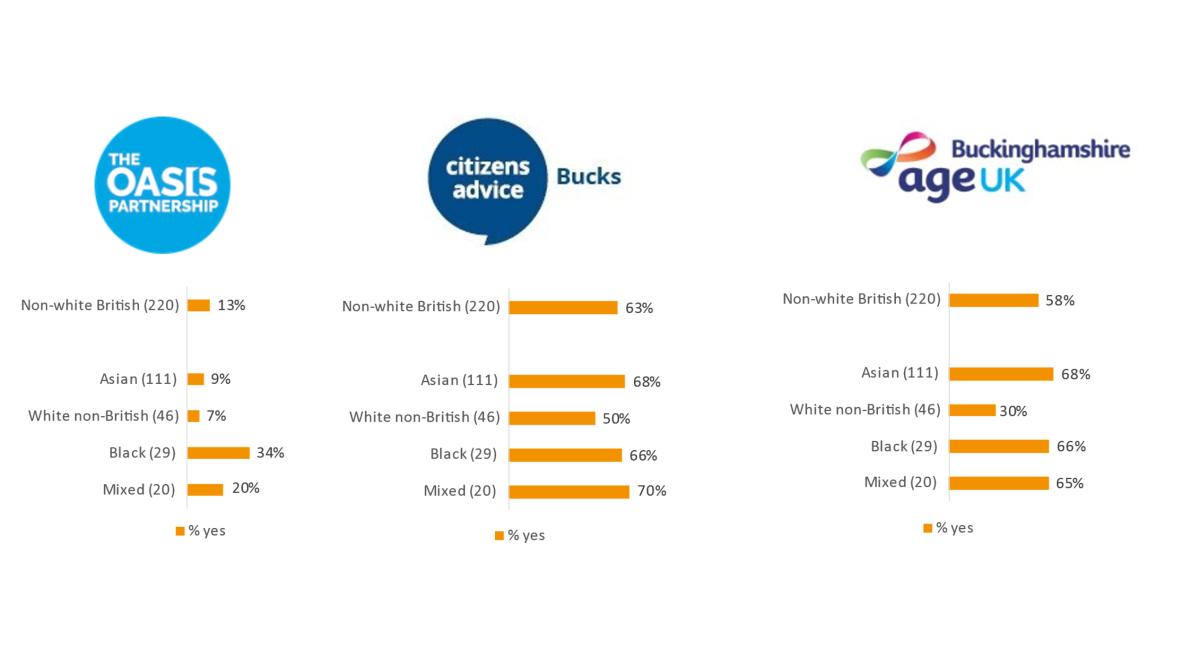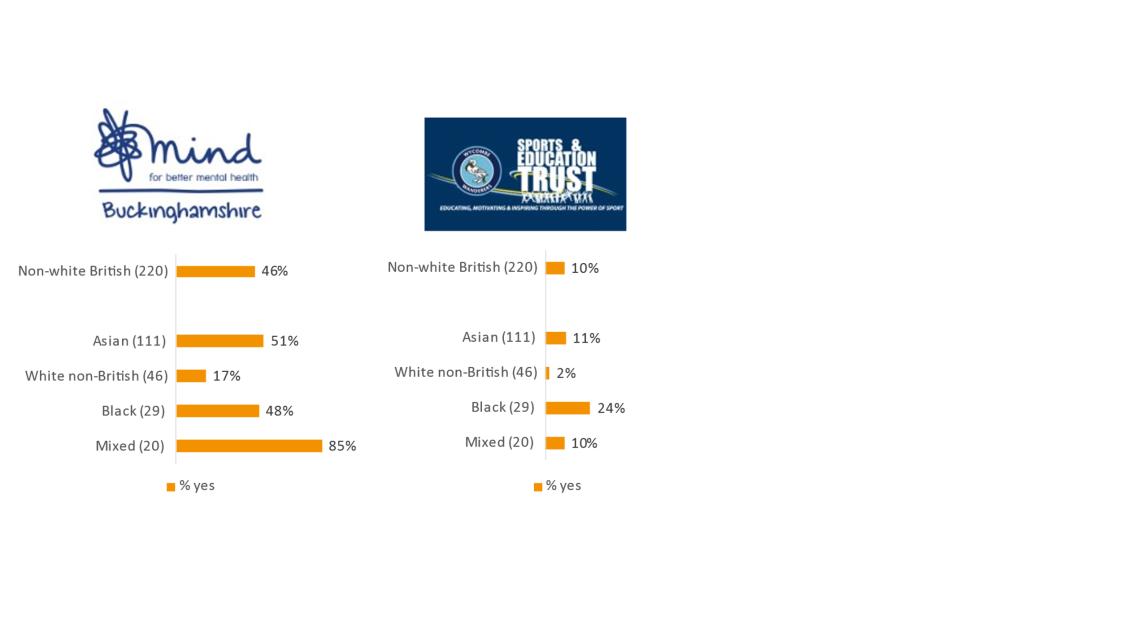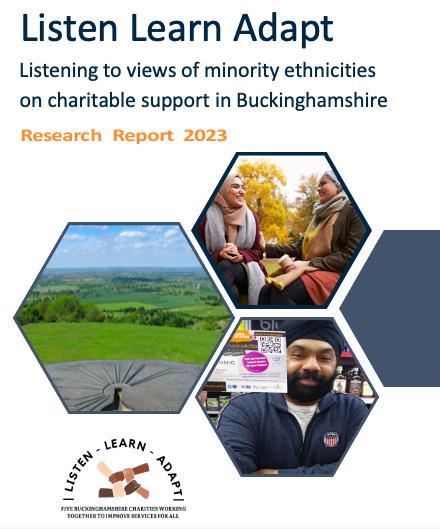

Project details and acknowledgements
Title Listen, Learn, Adapt - Listening to minority ethnic experiences
Client Listen, Learn, Adapt Partnership
Project number 21052
Authors Steve Handley, Kate Owen, Naved Siddiqi
This project has been delivered to ISO 9001:2015, 20252:2019 and 27001:2013 standards.
The project would like to give special thanks to:
▪ The Rothschild Foundation, Heart of Bucks and the Clare Foundation for funding this research.
▪ Naved Siddiqi whose enthusiasm and dedication ‘on the ground’ in Buckinghamshire was critical to the successful delivery of this project.

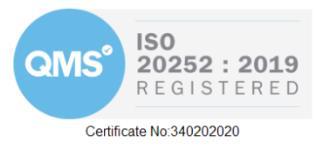
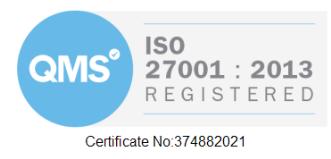
M·E·L Research Ltd
Somerset House, 37 Temple Street, Birmingham, B2 5DP
Email: info@melresearch.co.uk
Web: melresearch.co.uk
Tel: 0121 604 4664
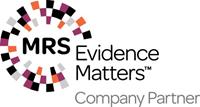
Executive summary
This project was commissioned by five Buckinghamshire charities which between them work to support the mental, physical, and financial wellbeing of Buckinghamshire residents. These charities agreed to work collaboratively to understand how they could better engage with communities that do not identify as White British under the banner of Listen, Learn, Adapt. This first, ‘Listen’ phase was a programme of community engagement with diverse communities across Buckinghamshire.
Key challenges of the research
The research methodology deployed needed to meet the challenge of reaching minority ethnic communities that are geographically spread across Buckinghamshire in a period in which Covid-19 transmission concerns produced some reluctance among individuals to have face to face engagement
This research was delivered through a mixture of targeted mailings/promotions and ‘on the ground’ engagement. Ultimately it was the latter activity, sharing flyers, identifying key community networks, stakeholders and gatekeepers which gave the project momentum.
Overall perceptions of charitable organisations
This research shows that residents within Buckinghamshire generally hold positive sentiments about charities working in Buckinghamshire and their intentions. Over eight in ten (82%) of all those who took part in the survey (including those of a White British ethnicity) agreed that charities in Buckinghamshire work to support people of “all ethnic backgrounds.” However, beneath this there appears to be some complexity to people’s relationships with charities. A quarter (24%) of Black respondents and three in ten (30%) Mixed ethnicity respondents disagree that Buckinghamshire charities work to support people of all ethnic backgrounds suggesting a lack of connection among some groups.
While there is little evidence to suggest that there is suspicion of the motives of charitable organisations, responses do suggest that some minority ethnic groups (Indian, Pakistani, and Black communities) are more likely to disagree than agree that charity support services are for people like them. While we cannot be certain that respondents answered this question solely through the prism of their ethnic identity, the qualitative research responses do suggest that more needs to be done so that communities feel that charities understand their specific cultural identities and needs. Actions in relation to recruitment, volunteering training, and governance all have the potential to better demonstrate that charities both understand and respond to differences.
A perceived lack of visibility of local charities within communities adds context to these findings. Shifting such perceptions is likely to need targeted interventions, informed by the data within this report. Collaboration and partnership working between individual charities may well be helpful to demonstrate community presence and how positive outcomes are being delivered
Barriers to engagement with charitable organisations
There is complexity to the barriers that prevent vital support services reaching local households. Visibility, perceived representation, cultural norms, and stigmas plus direct personal experience can all contribute to individuals choosing not to seek charitable support. There was a tendency by research participants to conceptualise charitable services as those used predominantly in crisis situations. This is more prevalent for organisations whose services are more preventive and proactive in nature.
Three in in five (60%) of respondents agree that they don’t think charities understand the needs of their ethnic community Where the nature of the help needed is of a sudden and urgent nature, such as help for domestic violence and alcohol-related suffering, local charities became a more obvious lifeline. However, for such issues, cultural norms within minority communities make these issues even more sensitive.
These sensitivities mean that the ability for charities to make early interventions for individuals in some communities may be reduced relative to other groups. This in turn may shape the nature of the support these individuals subsequently require.
The cultural norms and sensitives that respondents in this research identified mean that the services offered need to have cultural competence, including the tailoring of services to specific communities so that individuals can reach out with trust and confidence. The language used by some participants in this research ‘stigma’, ‘pride,’ ‘scared’ is illustrative of the emotional barriers for some, even when a need for support is identified.
For some individuals from minority ethnic communities, a lack of charity representatives with similar identities can cause individuals to question if the charitable support is for them, or will be able address their need. Black respondents express the lowest levels of trust in charities. Furthermore, a quarter of Black respondents (24%) expressed worries about why charities want to help, double the average of all minority ethnic respondents. There is a perception that charities need to do more at board, management, and staff level to reflect and represent society and beneficiaries.
This complexity suggests that there is no single silver bullet for driving engagement with support services. Representation that feels authentic, with relatable case studies of support delivery could support effective engagement and service delivery.
The research generated several ideas and opportunities to engage with minority ethnic groups. This research also shows that once individuals are provided with an appropriate forum, potentially sensitive issues can be discussed with openness and candour. This is encouraging, suggesting opportunities to learn more can be cultivated.
“I think charities are not trusted within my ethnic community because the workforce does not always reflect the people they are supposed to be helping. Charities need to engage with communities and try to recruit people from different ethnic groups.”
“If you’re talking about something as personal as that but you’re not connecting with the person you’re talking to, because they don’t understand your background, you’re never going to build that rapport and that trust for you to get the support that you need.”
“The lines of desperation are different for different communities.”
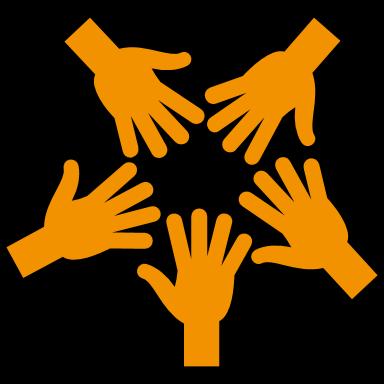
“Charities need to advertise themselves better, simple.”
“We need people of colour working in charities in positions of power; they come with knowledge.”
“In our communities there is always that thing where pride stops people asking, like it’s something really weak to go to a charity; better to suffer it out.”
“It is perceived as embarrassing and airing your dirty laundry if you go outside of the family group for help, let alone the community. Women particularly are seen to just need to get on with it and mental health issues are not believed ”
Introduction Background
This project was commissioned by five Buckinghamshire charities which between them work to support the mental, physical, and financial wellbeing of Buckinghamshire residents. These charities agreed to work collaboratively using their local networks to understand how they could better engage with communities that did not identify as White British.
The five charities who commissioned this research are:
▪ The Oasis Partnership (Lead Charity)
▪ Age UK Buckinghamshire
▪ Buckinghamshire Mind
▪ Citizens Advice Bucks
▪ Wycombe Wanderers Foundation
The project was generously funded by a grant from the Rothschild Foundation, Heart of Bucks, and the Clare Foundation.
The name chosen for this initiative was Listen, Learn, Adapt (LLA), with the Oasis Partnership providing the project lead. It was so named to reflect three phases of exploration, to listen to, learn from, and consider adaptations to services and operations, because of this research. It is envisaged that this could well be a circular process, where a phase of listening follows on from the changes made. This report centres on research undertaken in the initial listening phase and provides future recommendations based on this learning.
Research Context
Health and wellbeing outcomes in the UK are uneven. The landmark study Fair Society, Healthy Lives (The Marmot Review, 2010)1 embedded the paradigm of the social determinants of health in public health. Social determinants of health are the conditions in which people are born, grow, live, work and age. They include factors like socioeconomic status, education, neighbourhood and physical environment, employment, and social support networks.
1 https://www.instituteofhealthequity.org/resources-reports/fair-society-healthy-lives-the-marmot-review
In early 2020, ten years on from his original review, Professor Marmot provided an update on the ongoing challenge of improving public health in England. This publication identified that since 2010, life expectancy in England has stalled for the first time, while differences in health inequality both within and between regions have tended to increase. The events of 2020 brought the impact of health inequalities into the limelight. Evidence suggests that the impacts of Covid-19 have played out unevenly across age, wealth, and ethnicity.
In the British Medical Journal, a January 2021 article titled Mitigating ethnic disparities in Covid-19 and beyond states: “On almost all health measures, ethnic minority groups, especially Black and South Asian people, have the worst outcomes. The Covid-19 pandemic is just another example.” https://doi.org/10.1136/bmj.m4921
In simpler terms, with some minority communities having poorer physical and mental wellbeing, the ability of charities to reach and support these communities is vital. Disproportionately low engagement by third sector organisations with some ethnic groups risks widening social inequality further, as well as disadvantaging individuals who are not provided with help and support that can make a difference to their lives. The LLA project seeks to ascertain how support services in Buckinghamshire can be more inclusive and can offer more culturally appropriate support to more people in the community, leading ultimately to improved health and wellbeing.
• The Oasis Partnership: Oasis Partnership: offers drug and alcohol misuse treatment and support throughout Buckinghamshire. In addition to this they also offer employment, training and education focused support - helping people achieve their full potential. www.oasispartnership.org
• Citizens Advice Buckinghamshire: Offers free, independent, confidential and expert advice www.citizensadvicebucks.org.uk
• Age UK Buckinghamshire: Works with and for older people in Bucks to make a real, positive difference tot their wellbeing and independence, through our Information and Advice Line, Befriending, Welfare Benefits guidance, Hospital Discharge and home support services. www.ageuk.org.uk/buckinghamshire
• Wycombe Wanderers Foundation: The official charity of Wycombe Wanderers FC working across four key areas to support local people and communities to thrive; health, education, sports participation, and social inclusion. www.wycombewanderersfoundation.co.uk
• Buckinghamshire Mind: offers services focused on prevention, wellbeing and recovery, crisis support and talking therapies www.bucksmind.org.uk
Which community groups?
Preliminary consultations with existing networks known to the charities pointed to initial challenges and sensitivities when locating the scope of this research. Who were the community groups researchers should aim for, and how should publicity be labelled? Were there specific sensitivities to be aware of, and could some community groups be overlooked?
These consultations suggested that although no one terminology or description was agreeable, certain phrases were less suitable or appropriate. The commonly used expression “BAME” for example, that is, “Black, Asian and Minority Ethnic”, was considered impersonal and lacking sincerity. The term “Ethnic Minority” on the other hand was received by some as being quite “othering”, because of the “ethnic” element being prioritised.
The research team was also mindful of the common mistake of assuming a “non-white” make up of anyone identifying as minority ethnic. It was just as important to reach and offer participation to minority ethnic citizens who also identified as white, particularly citizens of a Polish or East European background. The research wanted to listen to local citizens, of all colours, who identified in any way, as a minority or ethnic.
The term “minority ethnic” was chosen to prioritise the “minority” element of the term, which was to be used in an explanatory style where possible, so that any citizen who identified “in any way” with the term could qualify themself for the research. This includes those of a ‘Mixed’2 ethnicity,’
Covid-19 considerations
This research was commissioned and delivered during a period of varied Covid-19 related restrictions. This has two implications for this research: -
• Firstly, the engagement methods deployed needed to comply with the restrictions in place at that time For example, focus groups were conducted online to help accommodate any hesitancy among people to be near others.
• Secondly, the timing of this research meant that it was conducted in period in which issues and concerns about family finances, health and wellbeing could have been at the forefront of the lived experiences of many, creating new challenges for some and exacerbating existing challenges among others. Simultaneously the operations of charitable support services were
2 Mixed ethnicity options were presented to respondents in the survey, with this terminology in line that used by the Census 2021
disrupted. While there was minimal direct reference to the pandemic in the discussions undertaken, the context and circumstances surrounding the research should be considered when interpreting the research messages.
Research and methods
To reach minority ethnic residents in Buckinghamshire, three complementary consultation approaches were used:
1. An online survey, promoted to the public
2. Focus groups, shaped by emerging findings from the survey
3. Interviews, exploring issues emerging from data and focus groups
By definition, the target audience for this research was neither homogenous, nor easily reached by a single list or database In person engagement with communities across Buckinghamshire was anticipated from the outset, to build trust in the research and to tap into existing networks
The initial project plan to recruit an outreach team drawn from the minority ethnic communities we wanted to engage with proved unsuccessful It was envisaged that these community researchers would be drawn from within Buckinghamshire and would have an existing understanding of their own ethnic community that would enable them to drive participation in the research and build confidence in its objectives. However, an extensive recruitment phase including a round of interviews did not identify suitable candidates for this role. Instead, a dedicated community researcher (with 20 years of experience) was recruited to make the necessary community connections, hold qualitative discussions, and promote the research both online and in community settings (flyers, posters etc).
Quantitative survey method
The first engagement tool that was rolled out was a bespoke online survey that was developed in collaboration with all five charities. This survey contained a mix of closed (tick box questions) as well as open (text-based questions) in which respondents could explain their answers. The final question set can be found in Appendix A
The survey was open to all who live in the Buckinghamshire Council area (which excludes Milton Keynes). Residents who identified as White and English, Scottish, Welsh or British could complete
some sections of the survey – they skipped the more detailed sections dealing with one’s experiences with charities. All other White ethnicities had access to all the survey questions.
Deployment of this survey was via highly targeted postal mailing to locations known to have a high incidence of minority ethnic communities and through community-based promotion. More details on these two approaches can be found within Appendix B, but in summary the targeted mailing only generated limited take up, with the community-based activities giving the project transition and momentum. This is a key learning from this project to take forward into future engagement activities.
Qualitative method
Five focus groups were conducted online, involving 37 participants. Some focus groups were designed to be among those with a shared identity so that individual experiences could be compared and discussed. All participants had either seen or answered the online questionnaire, and the sessions were designed to be informal, relaxed conversations within a safe space, with no judgments and no right or wrong answers.
Ten one-to-one in-depth interviews were also conducted with individuals who hold specific experience or expertise on the subjects this research sought to explore as follows:
1. Experienced community volunteer - Black Pentecostal church
2. Bucks Councillor – Chair of minority ethnic communities outreach group
3. Chair – Black Lives Matters, Berkshire, resident of Buckinghamshire
4. Communications and branding expert for community charities
5. Refugees support group leader, Bucks
6. Women’s group team leader, Bucks Mosque
7. Local community radio / Author on black studies
8. Experienced specialist – Minority ethnic women’s issues
9. Sports trainer – community football for minority youth
10. Psychotherapeutic Counsellor – Bucks – Minority ethnic patients
Who answered the survey?
By the end of February 2022, the completed survey responses had reached 267 (exceeding the project target of 250). Of these, 37 identified as “White British” and one did not state their ethnicity This meant 229 responses were received from citizens who expressly identified as being minority, ethnic and living in Buckinghamshire.
The diversity of participants who engaged with the online survey is shown by Table 1. Although the numbers of respondents identifying with some of these ethnic groups are too small to be of statistical significance when viewed in isolation, Table 1 does demonstrate that the engagement methods deployed delivered research that was ethnically inclusive.
Table 1: Which of the following ethnic groups best describes you
To put these results into context, in the 2011 Census, 86% of the Buckinghamshire population identified as white British. The largest minority communities within Buckinghamshire according to the Census are Other White (4.1%) Pakistani (4.2%) Indian (2.2%) Black (2.1%) All these key groups were reached by this research.
Further detail on the profile of the survey sample can be found in Appendix C. With a diverse range of residents engaged, some methodological factors are evident in the sample profile achieved
• In terms of religion, Muslims (from different ethnic backgrounds) make up the largest share of respondents (46%). An estimated half of these would be from communications and promotional visits to mosques at a time of the communal Friday prayer.
• In terms of gender, 44% of respondents identified as male, 48% as female, with the remainder not providing a response to this question in the online survey. On the ground conversations and communications were welcomed and not met with by resistance from any gender of any ethnicity, by our field researcher.
• Approximately 1 in 10 respondents were disabled in some way, with female respondents slightly more so. This is welcome news of participation in this research, but this would be lower than the national proportion of disabled people (the Family Resources Survey 2020-21 states 21% of working age adults are disabled in the UK).
Interpreting the survey data
The possibility of White British residents taking part in the research and the fact that respondents did not have to provide their ethnic background, means that survey data needs to be presented carefully to provide clearer insight into survey responses. The survey was distributed using postal, physical, and digital means as explained earlier, and contained filters (including a postcode check) at the start to ensure only Bucks residents could proceed. Although White British respondents could complete the survey, they would then bypass the more detailed questions concerning experiences and areas of need. So, for some measures such as the overall perceptions of how charities in Buckinghamshire operate the data is presented based on all responses. For other indicators where the views of minority communities are central to the question posed, a filtered sample base is used which excludes those who are White British and those whose ethnic group is unknown. Data presented in this way is labelled as ‘All minority ethnic responses.’
Some analysis is provided for specific ethnic identities where the sample sizes were robust enough to allow this. In some cases, it has necessary to collate ethnic identities within the same group, to make the sample bases robust. For example, all ethnic identities beginning with “Black” (such as BlackCaribbean) have been collated into a “Black” group
Interpreting the qualitative insight
Whilst qualitative research offers unique insight into people experiences, views, and perspectives, how it is done is crucial to contextualise the insight that is delivered. There are numerous stages where researcher bias may affect the research such as the discussion guide, interview process and analysis. Extra care also needs to be taken when working with people where English is not their first language.
Our discussion guides were written in plain English, and we always asked participants to explain their answers rather than making assumptions about their responses.
The output from the focus groups and interviews has been analysed to help provide context, nuance, and clarity alongside the survey data. The selected quotes used help to illustrate key findings using the voice of participants.
What Bucks residents think about charities
Within the quantitative survey, as a means of entry into the subject matter, all respondents were asked whether charities in Buckinghamshire work to support people of “all ethnic backgrounds”. Among the total survey sample there was a strongly positive opinion overall regarding the approach of charities working in Buckinghamshire. Over eight in ten (82%) of all those who took part in the survey (including those of a White British ethnicity) agreed that charities in Buckinghamshire work to support people of “all ethnic backgrounds”. This proportion includes 52% who gave the most positive response possible of ‘agree’
Figure 1: Do you agree or disagree with the following statement, “Charities in Buckinghamshire work to support people of all ethnic backgrounds”
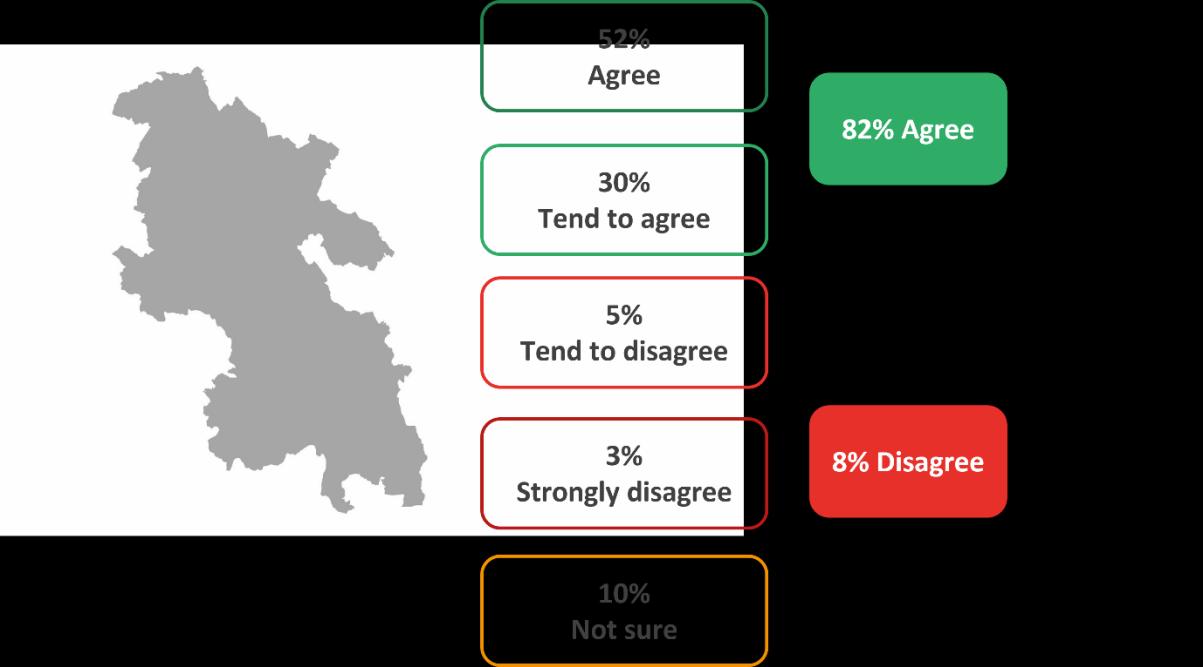
Sample base: All responses: 267
This positive sentiment regarding charities in Buckinghamshire working to support people of all ethnic backgrounds is found equally among those who are White British (81%) and those from all minority ethnic groups (83%). However, more granular analysis shows that a quarter (24%) of Black respondents and three in ten (30%) Mixed ethnicity respondents disagree that Buckinghamshire charities work in this way.
Figure 2: Do you agree or disagree with the following statement, “Charities in Buckinghamshire work to support people of all ethnic backgrounds” – responses by ethnic group
White British (37)
Minority Ethnic groups (total) 229
Asian (111)
White non-British (55)
Black (29)
Mixed (20)
Strongly agree Tend to agree Tend to disagree Strongly disagree Not sure
In a follow up question respondents were asked whether they believe that charity support services are for “people like me ” In response, 46% of those from minority ethnic groups agree this is the case, while a similar proportion (48%) disagree. The remaining 6% were unsure.
A granular breakdown of these responses is provided below. This question did not directly reference ethnic identity; questions later into the survey address this issue more directly. However, as is shown in Figure 3, some variations in opinion are evident by ethnic group. White British residents were least likely to suggest that charity support services are for people like them, with this comparatively low agreement in part due to 19% answering ‘not sure’. In minority ethnic groups, uncertainty in the form of ‘not sure’ responses was less evident. Furthermore, those who identify as Indian, Other Asian and Black are more likely to disagree than agree that charity support services are for people like them
Figure 3: Responses to
Strongly agree Tend to agree Tend to disagree Strongly disagree Not sure
While there may be more to do to develop a sense that charities are there to support all communities, there is little evidence to suggest that there is suspicion of the motives of these organisations. Over three quarters (77%) of those from minority ethnic communities disagree that they are worried about why charities want to help. Although 12% did expressly state a worry, only 1% strongly agreed with this statement
Figure 4: Responses to the statement “I am worried about why charities want to help”
Sample base: All minority ethnic respondents: 229
Within the qualitative research there was considerable appreciation and acknowledgement that Buckinghamshire is by and large a “good place”, where people were “generous” and “helpful” and charities provide considerable support, often going “beyond” and “bending over backwards” to help. Charities in Buckinghamshire and those who work for charities (paid or volunteers) are often seen as passionate and committed to helping vulnerable people in the area. People who work in charities are seen to be ‘friendly, welcoming and ‘want to help those in need’ Several participants shared positive personal experiences of receiving support from a local charity.
“We moved here from another country, and before we could find a job, I was scared we would run out of money, so I did get help from a food bank. The experience was really smooth because they don’t question you about anything, they take your word for it, and they immediately sent us four enormous boxes of help.”
“I know how hard they work, I know that in the evenings these are volunteering people so they leave the warmth of their homes and they get in their car and drive to Tesco or some other store to collect this, they spend at least a half hour there maybe an hour there collecting all the stuff and they have to lift the crates and everything they have to put it in their car.”
When exploring ‘who are charities for?’, there were no specific references to charities intentionally favouring one group over another. Moreover, charities were felt to support and help anyone who needed help, regardless of race, religion, gender, or sexuality.
That said, many did share comments that charities can lack connection to specific cultural identities and an understanding of the cultural needs of minority ethnic communities. This can translate to charities appearing cautious/tentative on such issues. Further data analysis of what local citizens think of charities will be explored in a later report section titled ‘Understanding the Barriers’
Lack of visibility at a community level
A key theme that was observed in both the qualitative and quantitative research was a lack of visibility of local charities in ‘their community’ – be that physically, or through digital and social media platforms. For some, the most visible presence was through charity shops This can result in low levels of awareness of specific charities and there was a perception that unless you knew that charity was there, you wouldn’t come across them through personal networks or community groups. To this end, we did hear that more ‘face to face outreach’ work needed to be done to raise their profile, particularly through religious groups.
“I don’t think there is much visibility of what some charities do in this area. And it’s definitely by some word of mouth which is what I found. If you know somebody, or you’re willing to open up and speak to somebody and give them an insight into your personal situation, then they will be like “Oh, yeah, there is this charity...”
“Because I’ve been in the church for over 30 years, and I’ve never seen once anyone come in to talk to our church leaders about what there’s available for people. And we deal with sometimes homeless people, all kinds of people. We have to go out and find help for them ourselves or direct them to who we think. But we never ever get approached.”
“I worry that if I was to reach out to a local charity there may be people there who know the family. I am speaking from personal experience.”
What can this tell us?
This research shows that residents within Buckinghamshire generally hold positive sentiments about charities working in Buckinghamshire and their intentions
However, beneath this there appears to be some complexity to people’s relationships with charities A quarter (24%) of Black respondents and three in ten (30%) Mixed ethnicity respondents disagree that Buckinghamshire charities work to support people of all ethnic backgrounds.
While there is little evidence to suggest that there is suspicion of the motives of these organisations, responses do suggest that some minority ethnic groups are more likely to disagree than agree that the charity support services are for people like them. While we cannot be certain that respondents answered this question solely through the prism of their ethnic identity, the qualitative research responses do suggest that more needs to be done so that communities feel that charities understand their specific cultural identities and needs. Actions in relation to recruitment, volunteering training, and governance all have the potential to better demonstrate that charities both understand and respond to differences.
A perceived lack of visibility of local charities within communities, adds context to these findings. Shifting such perceptions is likely to need targeted interventions, informed by the data within this report. Collaboration and partnership working between individual charities may well be helpful to demonstrate community presence and how positive outcomes are being delivered.
The need for charitable support
Identified support needs
Respondents were asked if they needed or knew someone that needed help over the last 12 months, for a range of listed issues Nine in ten (93%) stated they did for one or more of these issues This provides an indication of the level of opportunity for different charitable services to offer support. The period of 12 months in question was clearly impacted by the pandemic and these levels of need should be viewed in this context. It would be an over-simplification to suggest that Figure 6 represents an exact quantification of the support needs of minority communities within Buckinghamshire.
Coupled with discussions explored in focus groups, however, the general findings here demonstrate the relative prevalence of late pandemic concerns within the communities we engaged with.
Money worries (55%) and help with finding a job or reskilling (50%) both affected the social network of at least half of respondents. Aligned to that, over a third of respondents stated physical health (39%) mental wellbeing (38%) and housing issues (35%) generating potential support needs over the past 12 months.
Figure 6: Have you or someone you know needed help, advice, or support on any of the following in the last 12 months?
Money worries (e.g. furlough, claiming benefits, debts etc)
Help with finding a job or re-skilling
Help to improve physical health
Help to improve mental health and wellbeing
Housing advice/homelessness
Help/activities to support loneliness/feeling isolated
Help with training/finding a course
Domestic violence/abuse
Drugs and alcohol
Immigration advice
Other
None of these
At lower levels, around one in five said they knew someone who needed help with domestic violence/abuse (21%), drugs and alcohol (17%), or immigration (17%). All these needs represent opportunities for support services to make a difference
In subsequent chapters of this report, analysis is presented which shows the extent to which support organisations might make a difference on individual issues such as mental health, drugs and alcohol and domestic violence. However, it is pertinent to preview these detailed findings here. While friends/family and internet searches are consistently identified as key sources of help and advice, a role for local charities in providing support for some issues is identified.
Survey respondents most commonly indicated that they would seek help from local charities in relation to domestic abuse/violence and mental health issues even though these are among the most sensitive of issues presented in the research. Local charities are also more likely to be used as a source of help in relation to homelessness and isolation.
Help from charities is most likely to be sought by minority ethnic groups in relation to…
Domestic abuse/violence: 40%3
Help to improve mental health and wellbeing: 38%
Housing advice/homelessness: 30%

Help/activities to support loneliness/feeling isolated:29%
Help from charities is least likely to be sought in relation to…
Immigration advice: 5%
Help to improve physical health: 7%
Help with finding a job or re-skilling: 10%
Help with training/finding a course: 10%
3 These figures have been extracted from Figures 9-17
The focus group discussions provided narratives around some of these needs, and why important services may not be reaching some communities.
• Charitable services were often perceived as being there for people who had reached a point of “crisis” or had hit “rock bottom.” There was an image of the kind of person or households that called upon support charities, which denoted weakness and/or high vulnerability.
• Families from some communities have different thresholds to reach before help would be sought. Participants felt that for the same or like-for-like issue, an individual from one ethnicity would not seek help where someone from a White British ethnicity would. This was explained in two groups as levels of one’s independence being culturally informed and strongly influenced by it.
“The culture of independence is not understood so well. It’s different for different groups. There is pride in the black community. It stops people from asking for help from something like a charity.”
“Community stigmas need to be understood better through internal training and reaching out a lot more.”
“In our communities there is always that thing where pride stops people asking, like it’s something really weak to go to a charity; better to suffer it out.”
• Charitable services can be seen as providers of handouts to the extremely poor, typified by public discourses around foodbanks. Services were seen as being responsive to urgent and sudden family needs, such as at Christmas time or natural disasters Positive community efforts such as the Community Fridge and efforts during the pandemic for some, reinforced such notions In this context, practical, non-emergency support e.g., help with finding work is not identified as a role local charities undertake.
“Even I wouldn’t think of some of these places to help find work. If they can help with CVs and job interviews, this should be better known.”
“They would never think of going there for that kind of thing. Even I’ve learned something from this.”
• Several participants expressed views concerning the “market” of charities, and the confusion of getting through to the right kind of support. Suggestions were made that access was only possible if one knew where to look and/or “had a contact”. This meant the range of support services are not being accessed because communities “don’t have the knowledge of what they do.”
“Can we have a bridging organisation… a central database; (providing information on) what charities are good at; people can connect with them, and they can share resources.
People just don’t know where to look.”
“Where do people like ours begin to look though? People ring the council and ask their friends and that’s all they do. It’s such an unknown service.”
• In the focus group discussions, it was evident that some community specific needs were identified but people were “too scared” to talk about them openly. Similarly, one group felt charities were also “scared” to promote services aimed at their ethnic community Two participants spoke of alcohol leading to domestic violence challenges for women, making express references to Sikh and Polish households. While this is an area where support may be beneficial, it was clear that this was a highly sensitive topic.
“Substance abuse is never spoken about in our community, but it’s there.”
“They (referring to a Sikh woman’s household) just have to suffer in silence, it’s (alcoholism) a hidden problem, hush-hushed.”
“Charities are really too scared to do this ”
What can this tell us?
Misconceptions about what charitable organisations within Buckinghamshire can offer risks lower levels of service engagement. The tendency by research participants to conceptualise charitable services as those used predominantly in crisis situations is of particular note for organisations whose services are more preventive and proactive in nature.
Where the nature of help needed is of a sudden and urgent nature, such as help for domestic violence and alcohol-related suffering, local charities became a more obvious lifeline. However, for such issues, cultural norms within minority communities make these issues even more sensitive.
These sensitivities mean the ability for charities to make early interventions for individuals in some communities may be reduced relative to other groups. This in turn may shape the nature of the support these individuals subsequently require.
The cultural norms and sensitives that respondents in this research identified mean that the services offered need to have cultural competence, including the tailoring of services to specific communities so that individuals can reach out with trust and confidence. The language used by some participants in this research ‘stigma’, ‘pride,’ ‘scared’ is illustrative of the emotional barriers for some, even when a need for support is identified.
How and when those in need become aware of the support available to them is a key question posed by this research Strong and clearly identifiable local networks could make a valuable difference to many more in need of help.
Understanding the barriers
To help identify potential barriers that might prevent or inhibit ethnic minority communities from engaging with local support charities, all those participating in the online survey were asked to respond to eleven statements on an agree-disagree scale. The responses given are summarised in the figure below.
Figure 7: Level of agreement regarding possible barriers to engaging with charities
For people who don’t speak English as their first language, getting help and support is difficult
I don’t think charities understand the needs of my ethnic community
I have other sources of help and advice so I don’t need to go to charities
I don't believe charity support services are for people like me
I don’t know where to go or look to get help or advice
I would worry about a charity keeping information private and confidential
Charities don’t do enough to understand the needs of different ethnic communities
I would be concerned about people in the charity judging me/stigma
I have heard of examples of people working in charities being racist
Charities are not trusted amongst people in my ethnic community
I am worried about why charities want to help
Agree Disagree Not sure
Sample base: All minority ethnic respondents: 229
These responses suggest that:
• Language issues are most identified as a potential barrier to accessing support, with seven in ten (71%) minority ethnic respondents agreeing that for people who don’t speak English as their first language, getting help and support is difficult. This proportion includes 36% who strongly agree that this is case.
• Three in in five (60%) endorsed a statement that is at the heart of this research, agreeing that they don’t think charities understand the needs of their ethnic community. This proportion is equal among those who are Asian (63%) and Black (66%). Overall agreement that charities don’t do enough to understand the needs of different communities is more muted (38% agree, 45% disagree).
• When considering whether communities trust charities, more minority ethnic respondents disagree (53%) rather than agree (20%) that charities are not trusted amongst people in their ethnic community. While this is a positive balance of opinion, the fact that one in five do indicate that charities are not trusted by their ethnic community suggests that a sizable proportion of those with support needs may not feel comfortable accessing care that could be of benefit to them. It should be noted that this lack of trust is strongest among those who are Black (45%). In the open comments section of the survey, respondents spoke of a lack of trust influenced by a lack of understanding of culture and the re-emerging issues of visibility and representation.
“Difficult to trust if charities don’t have people from ethnic communities in their management teams.”
“Using a service and seeing someone like you immediately breaks down one of the many barriers. Many workers in charities are not from different ethnic backgrounds, majority being White English.”
“There are not many people who work on the charity sector that look like me. I feel underrepresented.”
Respondents feel their own ethnic or other minority ethnic identities are generally under-represented in charities. This was seen to be the case with the workforce and volunteers of charities, senior leadership and on the boards of trustees, and in advertising, marketing, and social media communication materials.
“Actually, this service is for you!” and what I think is really important is when you pick up a bit of literature to see black and brown faces. When I look at things, I’m like, this is not really for me.”
“What they post on social media that might be the first place where you find information and I think for me that’s a big thing, but I think a massive turn off from charities is when you don’t see anybody that looks like you on their websites and I think that’s a really big thing especially with some of the charities maybe around this area.”
There was some suggestion that representation, can at times feel tokenistic.
“I would like to suggest maybe some of the charities look at their strategy for diversity and inclusion, and are they incorporating… I know they want to tick the box and have the token Black and the token Asian and the token Eurasian in their charities, maybe to do the pro rata thing. But beyond that, they need to look at getting people from different ethnic minorities in the workplace so that they can reach out to the communities. It’s coming from the community and not coming from a white person who’s trying to translate or trying to understand our culture and “Chinese message”
“I think there’s a really … kind of what’s the word … solid line between being genuine and being tokenistic and I think once that balance is found its probably quite an easy thing to achieve. I’ve definitely been used as a token before in institutions they want certain people to be on the front of posters or whatever, so they appeal more. But I think maybe it is quite a fine line but when you find it you know it’s just about being genuine I think.”
A further barrier that was identified and explored in the qualitative research, related to how cultural norms within communities acted as barriers to seeking out help and support from charities. These were largely described as community stigmas or sensitivities, which charities could not properly understand because of a lack of diversity within them. Black, Asian, and Chinese respondents described the community stigmas associated with reaching out for charitable help and support and how this might reflect on their standing and reputation within the community.
“It is perceived as embarrassing and airing your dirty laundry if you go outside of the family group for help, let alone the community. Women particularly are seen to just need to get on with it and mental health issues are not believed - they think you're mad.”
“In some Asian communities it is seen in a somewhat negative light. There appears to be a feeling that one is the lowest of the low and unworthy of respect if you are in need of help. The implication being that if you need help then you are not working. If you aren’t working, then you’ve done something wrong it there is something wrong with you.”
“So, because in the Black community I think there’s a lot of people with pride that perhaps do get to that level of desperation because they might feel judged by their peers if they’re seen to reach out to that. Some people can be quite judgemental. It’s like, ‘Well, why were you not able to manage your money? Why did you let it get that bad? Why you need to do this?’ And there’s a stigma and a shame, and so they allow it to get that bad. And then when it gets that bad, and they do need to go to a charity for help, the help doesn’t come quick enough. And that’s that level of desperation that they reach, I think.”
Black respondents expressed the lowest levels of trust. Over half (55%) said they had heard examples of people working in charities being racist (compared to all minority ethnic respondents - 27%) of which 14% strongly agreed with the statement. A quarter of Black respondents (24%) were worried about why charities want to help, double the average of all minority ethnic respondents. Black participants in focus group spoke of the systemic racism that was embedded in the country and queried how charitable staff (who were not black) could understand their needs/perspectives. Again, these quotes highlight the difficult balance to be struck between representation and perceived tokenism.
“We need people of colour working in charities in positions of power; they come with knowledge. I would say Black people are invisible. Having them gives an element of trust and deals with white saviour ideas.”
“The people I see are all White. All of my problems are linked to my being Black, so how can they help?”
“Need to see more Black people as more positive and successful. Not just receiving the benefits of charities.”
“I felt very frustrated as the ‘advert’ Black person.”
“I do think you need Black people or ethnic minorities working in the charities, only because then they come with the knowledge.”
“The people that you do see, they’re White people. I’m not racist, but are they going to understand me? Or are they going to understand where I’m coming from, why is this a problem for me”
What can this tell us?
There is complexity to the barriers that prevent vital support services reaching local households. Visibility, perceived representation, cultural norms, and stigmas plus direct personal experience can all contribute to individuals choosing not to seek charitable support.
This complexity is rooted in trust, familiarity, and connection. Community grapevines can set and/or reinforce negative perceptions (“I’ve heard some are racist” or “will my data be hacked”) alongside the direct experiences of individuals. How Buckinghamshire charities are viewed is influenced by wider social forces and indeed service experiences with other organisations.
This complexity suggests that there is no single silver bullet for driving engagement with support services. Representation that feels authentic, with relatable case studies of support delivery should be the aspiration.
Effective Support for Minority Ethnic Communities
This report section explores perceptions about the issues for which the five LLA charities provide support. Survey respondents were asked in turn about issues of physical health, mental health, drugs and alcohol, money worries, and domestic abuse. This was done in two parts. The first explored the relationship between issues and their respective “ethnic community”, addressing matters of internal sensitivity and effective support. The second explored who they might turn to for help, for each of these issues.
Before these results are explored in detail the following should be noted:
• The questions are presented as a set of issues that affect or challenge a community group, where respondents are responding more as community voices about “my ethnic community”. The responses can therefore be seen as an observational assessment by an individual belonging to an ethnic group, and less so as the personal experience of the respondent.
• Issues can be “highly sensitive in my ethnic community” for different reasons, and both low and high scores can indicate opportunities. The qualitative research suggested charities should not be deterred by issues being sensitive. Indeed, they should find ways of understanding such issues better.
• The role of leaders and elders generated some critical discussions. Leaders/elders being a “strong influence” was not always seen as a positive. This was more the case with areas that were also sensitive, and where leaders/elders were seen as perpetuating taboos, as obstacles to change in the right direction, and even being part of the challenge or issue at hand.
Physical health
When considering the issue of physical health, more than two in five (45%) minority ethnic respondents indicate that this is an issue on which support providers can make a real difference with their community. However, to make a difference a quarter (25%) of this sample suggest that support providers need to look like them/their community. Notably one third (33%) of those responding regarding physical health issues suggest that these don’t translate well or aren’t easily understood within their community. Please note that more than one response was possible at this question (and in all similar questions in subsequent report sections).
Figure 8: Thinking about the issue of physical health, please tick which of the following statements you agree with?
This is an issue on which I think support providers can make a real difference in my ethnic community
This issue doesn’t really translate well/isn’t easily understood in my ethnic community
This is an issue for which support providers need to look and sound like me/my ethnic community
This is an issue that is highly sensitive in my ethnic community
This is an issue for which leaders/elders in my ethnic community are a strong influence
None of these
Don't know
Prefer not to say
Sample base: All minority ethnic respondents 220
All respondents were also asked to consider who they might turn to if they decided to ask for help to improve physical wellbeing. As will be seen repeatedly in this report, friends and internet searches are most commonly mentioned as key sources of help. The proportion who would seek help from a charity in relation to physical health (7%) is low, with doctors/healthcare professionals the external resource most likely to be used (45%).
Figure 9: If you decided to ask for help to improve physical health who might you turn to?
Internet search (e.g google)
Friends
Doctor or other health professional
Female family members
Male family members
Social media support group
A local charity
Local council
Community or Faith leader
Someone else
Don't know/Prefer not to say
Sample base: All minority respondents: 202
More granular analysis shows that Asian respondents are those most likely to state that the issue of physical health doesn’t translate well or isn’t easily understood in their community (Indian 48%, Pakistani 41%) compared to Black (10%) and Polish (30%) respondents. With the exception of Polish respondents, more or less half of the respondents felt charities could make a difference. These figures point to opportunities for engagement and service provision.
In a focus group of women who were Muslim with strong connections to a place of worship, participants spoke positively of their collaboration with sports charities, but expressed how physical activity sessions were particularly difficult if there were large windows (where people could look in), where the space was not only for females, and where there were male instructors
When it came to supporting people from different minority ethnic communities to be more active, we heard occasions of missed opportunities for more positive collaboration and more engagement from local charities to use / share spaces to build and develop community connections
“So the Hive is a community centre that our mosque owns, and Wycombe Wanderers hires it from us and they have been for three years but they’ve never made any attempt to engage our users with their services.”
A participant in another focus group also expressed an insightful view on health and wellbeing, from an Asian perspective.
“For our communities, it’s all about doctors and antibiotics. That’s all the thing. But our general health is not being looked at. Especially women I have seen in family and, you know the thing. People are too lazy it seems. It’s just doing some walking a little bit and that’s it… needs more education, more research.”
Mental health
The sense that support providers can make a real difference in mental health (52%) is slightly stronger than seen in relation to physical health issues (45%- see Figure 10 above). However, the challenge of doing so is also more strongly identified, with more than half of minority ethnic respondents suggesting that mental health is an issue that is both highly sensitive for their community (52%) and is something that doesn’t translate well or isn’t easily understood (58%). Notably, one quarter (26%) at this question state that this is an issue for which leaders/elders within the community exert a strong influence.
Figure 10: Thinking about the issue of mental health, please tick which of the following statements you agree with
This issue doesn’t really translate well/isn’t easily understood in my ethnic community
This is an issue that is highly sensitive in my ethnic community
This is an issue on which I think support providers can make a real difference in my ethnic community
This is an issue for which support providers need to look and sound like me/my ethnic community
This is an issue for which leaders/elders in my ethnic community are a strong influence
None of these
Don't know
Prefer not to say
Sample base: All minority ethnic respondents
220
If minority ethnic individuals decided to ask for help to improve mental health and wellbeing, an equal proportion would consider contacting a local charity (38%) as would reach out to a doctor or another healthcare processional (36%). This is a notable difference compared to physical heath, for which healthcare professionals are more likely to be consulted (See Figure 9 above).
Figure 11: If you decided to ask for help to improve mental health and wellbeing who might you turn to?
Internet search (e.g google)
Friends
A local charity
Doctor or other health professional
Social media support group
Female family members
Male family members
Local council
Community or Faith leader
Someone else
Don't know/Prefer not to say
Sample base: All minority ethnic respondents 220
In focus groups and interviews, participants drew attention to the impact of the pandemic on people’s mental health and how, for many ethnic minority communities, there were additional cultural and gender barriers to overcome in order to access support. Mental health needs were often described as being hidden within the family. We also heard again about the perception of charities being there to mainly support those who were very vulnerable, but perhaps not being there for those struggling generally, but not yet in crisis.
“I think it’s probably education for them. Like the Chinese. My mum’s got mental health problems. My dad, being a Chinese person, it’s not a real thing and it’s something that is dismissed. So, a Chinese person is less likely to go and ask for help if they have mental health conditions…”
“I have a male Algerian refugee or asylum seeker who is suffering depression this is a beneficiary and I have a volunteer who is a female, but she is a qualified psychotherapist who would love to start helping him, but we know there will be a clash. There are two things. First of all, she’s female and he’s male. And the second thing is maybe the stigma that you know that maybe Muslim men or Arab men will have in admitting that they are suffering from this problem so.”
Drugs and alcohol
More than two in five (44%) minority ethnic respondents agree that support providers can make a difference to their ethnic community in relation to drug and alcohol issues. Six in ten (59%) suggest that these issues are highly sensitive within their community, a proportion that is even higher than that reported above in relation to mental health. Only domestic abuse is more commonly identified as a sensitive issue.
Again, a quarter of respondents (24%) suggest that community leaders/elders within their community are a strong influence in relation to drugs and alcohol issues. This proportion rises to 27% among those who are Asian.
Figure 12: Thinking about the issue of drugs and alcohol, please tick which of the following statements you agree with
This is an issue that is highly sensitive in my ethnic community
This is an issue on which I think support providers can make a real difference in my ethnic community
This issue doesn’t really translate well/isn’t easily understood in my ethnic community
This is an issue for which support providers need to look and sound like me/my ethnic community
This is an issue for which leaders/elders in my ethnic community are a strong influence
None of these
Don't know
Prefer not to say
Sample base: All minority ethnic respondents: 220
For help about drugs and alcohol six in ten (63%) would undertake internet searches and two in five (41%) would seek help from friends. The proportion who would seek support on such issues from a local charity (32%) is equal to the proportion who would seek health from healthcare professional (29%) and a social media support group (30%).
Figure 13: If you decided to ask for help about drugs and alcohol who might you turn to?
Internet search (e.g google)
Friends
A local charity
Social media support group
Doctor or other health professional
Male family members
Female family members
Community or Faith leader
Local council
Someone else
Don't know/Prefer not to say
Sample base: All minority ethnic respondents: 202
The survey question does not separate drug addiction from alcoholism, but the focus groups conversations identified alcohol in particular as an issue.
“Substance abuse is never spoken about in our community, but it’s there.”
“They (referring to a Sikh woman’s household) just have to suffer in silence, it’s (alcoholism) a hidden problem, hush-hushed.”
Money worries
Almost half (48%) of minority ethnic respondents agree that support providers can make a difference to their ethnic community in relation to money worries. While some sensitivity is identified around such issues, this is to a much lesser extent than for mental health and substance issues.
Figure 14: Thinking about the issue of money worries4 , please tick which of the following statements you agree with
This is an issue on which I think support providers can make a real difference in my ethnic community
This is an issue for which support providers need to look and sound like me/my ethnic community
This issue doesn’t really translate well/isn’t easily understood in my ethnic community
This is an issue that is highly sensitive in my ethnic community
This is an issue for which leaders/elders in my ethnic community are a strong influence
None of these
Don't know
Prefer not to say
Sample base: All minority ethnic respondents: 220
For help in relation to money worries the proportion who would seek help from a local charity is relatively low at 16%. For this issue friends, family and the internet are likely to be key sources of help. Respondents also appear to identify the local council as being a potential source of support here (32%), notably more so than for other issues. This is likely to be related to the fact councils have responsibilities for handling applications for some benefits.
4 money worries (e.g., furlough, claiming benefits, debts etc)
Figure 15: If you decided to ask for help about money worries (e.g., furlough, claiming benefits, debts etc.), who might you turn to?
Internet search (e.g google)
Male family members
Female family members
Local council A local charity
Social media support group
Community or Faith leader
Doctor or other health professional
Someone else
Don't know/Prefer not to say
Sample base: All minority ethnic respondents: 202
In focus groups, participants said there was a general lack of awareness and understanding of how charities can support people more financially, outside of food banks or by helping individuals to navigate the benefits system. Again here, feeling judged and feeling stigma and shame for needing financial support are significant issues preventing support being accessed. There is considerable scope here for local charities to offer constructive, practical support for local households, especially in job seeking skills.
“I know when they get into money worries or housing worries the first port of call is the council and that is always a losing gamble and I think these charities don’t have standing on their own separate from the council, so most people just get bogged down and getting lost with council going on calls waiting and getting nothing. And then there are too fed up to go to the charities at that point.”
“I didn’t even know that role (Routes to Work support with finding a job) existed.”
Domestic violence and abuse
Six in ten (63%) of minority ethnic respondents indicate that domestic abuse is highly sensitive in their community, while two in five (40%) indicate that the issue doesn’t translate well or isn’t easily understood in their ethnic community. Two in five (39%) also identify elders/community leaders an influence on this issue, this being the highest proportion seen across all the issues asked about in this manner. Among those who are Asian the proportion mentioning the influence of elders/community leaders is 45%. On this basis, engagement with such leaders may be particularly necessary in order for support providers to have an influence in relation to domestic abuse.
Figure 16: Thinking about the issue of domestic violence abuse, please tick which of the following statements you agree with
This is an issue that is highly sensitive in my ethnic community
This is an issue on which I think support providers can make a real difference in my ethnic community
This issue doesn’t really translate well/isn’t easily understood in my ethnic community
This is an issue for which leaders/elders in my ethnic community are a strong influence
This is an issue for which support providers need to look and sound like me/my ethnic community
None of these
Don't know
Prefer not to say
Sample base: All minority ethnic respondents: 220
At 63%, domestic violence was the most sensitive issue – when measured by gender, 69% of females said this compared to 58% of male respondents. 34% of female respondents said the subject was not easily understood in their ethnic community (compared to 46% of males). Half of all female respondents (50%) said charities could make a difference (compared to 39% of males). Yet 38% of female respondents would turn to a local charity for support (compared to 50% of males).
For help with domestic abuse, despite the highly sensitive nature of this issue 40% would ask for help from a local charity. This is the third most likely source of support for this issue after the internet (63%) and friends (47%).
Figure 17: If you decided to ask for help about domestic violence/abuse who might you turn to?
Internet search (e.g google) Friends
A local charity
Female family members
Social media support group
Male family members
Doctor or other health professional
Local council
Community or Faith leader
Someone else
Don't know/Prefer not to say
Sample base: All minority ethnic respondents: 202
Comments on the cultural sensitives around this issue are provided below:
“If you’re talking about something as personal as that but you’re not connecting with the person you’re talking to, because they don’t understand your background, you’re never going to build that rapport and that trust for you to get the support that you need.”
“The word rape doesn’t even exist in their language. So, we try and reach out to that community so that they understand even marital abuse is abuse.”
What can this tell us?
Minority ethnic communities identify potential roles for local charities to make a “real difference” on several issues. This is a positive finding from this research; there is a hope and indeed expectation that charitable organisations find ways to reach those who need assistance.
Alongside this, clear messages are evident about how already sensitive issues – domestic violence, drugs and alcohol, and mental health interact with cultural perspectives and stigmas Some of these sensitivities are amplified by the influence of elders.
The operational goal of charities is to increase the proportion of those who would turn to a local charity for help. The data presented here provides an indication of how much work there is to be done in each of these important areas.
Recommendations
This research identifies support needs within minority ethnic communities that charities are ideally placed to address. However, some minority ethnic groups question if charitable support is for them or will be able address their needs
• More needs to be done to challenge the notion that charities are a source of support only in an emergency/at points of extreme need. Demonstrating examples where charitable support is light touch, targeted as well as culturally sensitive may well be helpful
• Careful consideration needs to be given to representation issues Visibility is importantcitizens want to identify visibly with the people they see representing charities. This extends to decision-making positions such as boards and senior management. Avoiding perceptions of tokenism is challenging, requiring communications and narratives that are authentic. As only residents can fully judge the authenticity of messages there is perhaps a role for minority ethnic communities being engaged to help shape these efforts.
• In addition to representation in charities, what more can they do to engage with other organisations and charities who already have strong connections with minority ethnic communities? Working collaboratively, sharing ideas, learning and networks is critical to the sector, so doing this with organisations that already have these connections, for mutual benefit, will reap many rewards.
• Cultural norms, stigmas, and power relations (e.g., the role of elders and gender relations) need to be given due consideration when shaping service design/interventions. Awareness of which issues are likely to be of heightened sensitivity for specific groups needs to be embedded within charitable organisations.
• The day-to-day interactions between personnel from charities and minority ethnic communities is vital for building trust, but also for learning about how to do better. Charities should seek to increase opportunities to engage with communities and should empower staff to share experiences and feedback. Embedding organisation-wide cultures to improve inclusivity, cannot be a solely top-down process.
• How and when those in need become aware of the support available to them is a key question posed by this research. Strong and clearly identifiable local networks could make a valuable difference to many more in need of help
Appendix A: Online survey questions
BUCKS LISTEN, LEARN, ADAPT
What you say is important. Your views will be confidential and you will not be personally identifiable in any reports. Your responses will be collected by M·E·L Research an independent research company. M·E·L Research follows the Market Research Society Code of Conduct, the MRS Fair Data Accreditation and Data Protection laws (GDPR) at all times. You can read their privacy notice at: www.melresearch.co.uk/privacypolicy.
Thank you for taking the time to help with this research.
Please click "Next" when you are ready.
Q1 - We just need to ask a few questions to make sure this survey is relevant to you.
Do you live in the Buckinghamshire Council area (previously this included Aylesbury Vale, Chiltern District, South Bucks and Wycombe district councils but excludes Milton Keynes)?
Yes (1)
No (2)
Don't know (3)
Q1 Please can you provide your post-code below:
Q2 - Which of the following ethnic groups best describes you?
White (23)
White - Welsh/English/Scottish/Northern Irish/British (1)
White Irish (2)
White - Gypsy, Roma or Irish Traveller (3)
White - Polish (4)
White - Romanian (5)
White – White Irish (6)
White Other (7)
Mixed (24)
Mixed - White and Black Caribbean (8)
Mixed - White and Black African (9)
Mixed - White and Asian (10)
Any other mixed background (11)
Asian - Indian (12)
Asian - Pakistani (13)
Asian - Bangladeshi (14)
Asian - Chinese (15)
Asian - Other Asian (16)
Black (26)
Black - African (17)
Black - Caribbean (18)
Black - Other Black (19)
Other (27)
Arab (20)
Any other ethnic group (21)
Prefer not to say (22)
Views on charities
Research has shown that minority ethnic groups are less likely to look for information, advice and support from charities and other support organisations when facing difficult situations. These support services could include, jobs and training, financial difficulties, advice around benefits, housing, mental health and wellbeing (including alcohol and drugs), immigration advice and support for loneliness. We want to understand whether this is the case in Buckinghamshire and if so, how this can be changed.
Q3 - Do you agree or disagree with the following statement, "Charities in Buckinghamshire work to support people of all ethnic backgrounds
Strongly agree (1)
Tend to agree (2)
Tend to disagree (3)
Strongly disagree (4)
Not sure (5)
Q3a - If you disagree, please can you explain why you feel this way? Any personal experience you share cannot be linked to you.
Q4 - To what extent, do you agree or disagree with the following?
I don't believe charity support services are for people like me (1)
I am worried about why charities want to help (2)
I have other sources of help and advice so I don’t need to go to charities (3)
Charities don’t do enough to understand the needs of different ethnic communities (4)
I don’t think charities understand the needs of my ethnic community (5)
Strongly agree (1)
Tend to agree (2) Tend to disagree (3)
disagree (4) Not sure (5)
I would worry about a charity keeping information private and confidential (6)
I would be concerned about people in the charity judging me/stigma (7)
I have heard of examples of people working in charities being racist (8)
For people who don’t speak English as their first language, getting help and support is difficult (9)
I don’t know where to go or look to get help or advice (10)
Charities are not trusted amongst people in my ethnic community (11)
Q4a - Please can you explain why charities are not trusted in your ethnic community? And do you have any suggestions about how this can be changed?
Q5 - Have you or someone you know needed help, advice or support on any of the following in the last 12 months?
Physical health is making sure your body is fit and well. Mental Health is about how we think, feel and act. It also helps to determine how people handle stress, relate to others and make choices.
Please tick all that apply
Money worries (e.g. furlough, claiming benefits, debts etc) (1)
Housing advice/homelessness (2)
Help to improve mental health and wellbeing (3)
Help to improve physical health (4)
Help/activities to support loneliness/feeling isolated (5)
Help with finding a job or re-skilling (6)
Help with training/finding a course (7)
Domestic violence/abuse (8)
Drugs and alcohol (9)
Immigration advice (10)
Other (please specify below) (11) ____________ [Keep position Other]
None of these (12) [Keep position Exclusive]
Prefer not to say (13) [Keep position Exclusive]
Q6 - Thinking about the issue of physical health, please tick which of the following statements you agree with:
Please tick all that apply
This issue doesn’t really translate well/isn’t easily understood in my ethnic community (1)
This is an issue that is highly sensitive in my ethnic community (2)
This is an issue for which leaders/elders in my ethnic community are a strong influence (3)
This is an issue for which support providers need to look and sound like me/my ethnic community (4)
This is an issue on which I think support providers can make a real difference in my ethnic community (5)
None of these (6) [Keep position Exclusive]
Don't know (7) [Keep position Exclusive]
Prefer not to say (8) [Keep position Exclusive]
Q7 - Thinking about the issue of mental health, please tick which of the following statements you agree with:
Please tick all that apply
This issue doesn’t really translate well/isn’t easily understood in my ethnic community (1)
This is an issue that is highly sensitive in my ethnic community (2)
This is an issue for which leaders/elders in my ethnic community are a strong influence (3)
This is an issue for which support providers need to look and sound like me/my ethnic community (4)
This is an issue on which I think support providers can make a real difference in my ethnic community (5)
None of these (6) [Keep position Exclusive]
Don't know (7) [Keep position Exclusive]
Prefer not to say (8) [Keep position Exclusive]
Q8 - Thinking about the issue of drugs and alcohol, please tick which of the following statements you agree with:
Please tick all that apply
This issue doesn’t really translate well/isn’t easily understood in my ethnic community (1)
This is an issue that is highly sensitive in my ethnic community (2)
This is an issue for which leaders/elders in my ethnic community are a strong influence (3)
This is an issue for which support providers need to look and sound like me/my ethnic community (4)
This is an issue on which I think support providers can make a real difference in my ethnic community (5)
None of these (6) [Keep position Exclusive]
Don't know (7) [Keep position Exclusive]
Prefer not to say (8) [Keep position Exclusive]
Q9 - Thinking about the issue of money worries, please tick which of the following statements you agree with:
Please tick all that apply
This issue doesn’t really translate well/isn’t easily understood in my ethnic community (1)
This is an issue that is highly sensitive in my ethnic community (2)
This is an issue for which leaders/elders in my ethnic community are a strong influence (3)
This is an issue for which support providers need to look and sound like me/my ethnic community (4)
This is an issue on which I think support providers can make a real difference in my ethnic community (5)
None of these (6) [Keep position Exclusive]
Don't know (7) [Keep position Exclusive]
Prefer not to say (8) [Keep position Exclusive]
Q10 - Thinking about the issue of domestic abuse, please tick which of the following statements you agree with: Please tick all that apply
This issue doesn’t really translate well/isn’t easily understood in my ethnic community (1)
This is an issue that is highly sensitive in my ethnic community (2)
This is an issue for which leaders/elders in my ethnic community are a strong influence (3)
This is an issue for which support providers need to look and sound like me/my ethnic community (4)
This is an issue on which I think support providers can make a real difference in my ethnic community (5)
None of these (6) [Keep position Exclusive]
Don't know (7) [Keep position Exclusive]
Prefer not to say (8) [Keep position Exclusive]
Q11n These questions deal with different challenges many households can face.
If you decided to ask for help about ^f('iQ11’) ^, who might you turn to?
Please tick all that apply
Friends (1)
Female family members (2)
Male family members (3)
Internet search (e.g. google) (4)
A local charity (5)
Local council (6)
Doctor or other health professional (7)
Community or Faith leader (8)
Social media support group (9)
Someone else (10)
Don't know/Prefer not to say (11) [Exclusive]
Q12 - Before this survey, were you familiar with any of the following five charities supporting this research?
Yes (1) No (2)
The Oasis Partnership (1)
Citizens Advice in Buckinghamshire (2)
Age UK Buckinghamshire (3)
Buckinghamshire Mind (4)
Wycombe Wanderers Sports & Education Trust (5)
Q13 - Have you, or someone you know, been supported by the following charities?
Yes (1) No (2) Prefer not to say (3)
The Oasis Partnership (1)
Citizens Advice in Buckinghamshire (2)
Age UK Buckinghamshire (3)
Buckinghamshire Mind (4)
Wycombe Wanderers Sports & Education Trust (5)
Q14 - Some of these organisations are part of national charities, who work in Buckinghamshire as well as well elsewhere in the UK.
Would you say you trust bigger charities more, less or about the same as local ones?
More (1)
Less (2)
About the same (3)
Don't know (4)
Q15 - Please can you explain why this is?
Q16What are the reasons, if any, for not using the following charity? (INSERT CHARITY)
No need (1)
They are not sensitive to my ethnic community (2)
I do not feel comfortable approaching them (3)
They do not understand my specific cultural needs (4)
They do not offer products or services that reflect my ethnic community (5)
They do not use language that reflects my ethnic community (6)
I do not see people from my ethnic community working for them (7)
I do not see people from my ethnic community on their website or other information they provide (8)
I do not want people in my community to judge me negatively (9)
The next three questions will help us understand more about your experiences, observations and views. The first asks what is working well. The second asks what is not working well. The third asks what can be done to improve things. Please write frankly – this is your opportunity to have a say.
Remember, no one will be able to link your responses to you (also, if your experiences relate to any of our five charities, do please name them).
Our charities want to reach and support families from all ethnic backgrounds, and do so well.
How are charities in Bucks doing this well? What is working? What do you feel is positive? Can you give examples?
Please type in the box below
How are charities in Bucks not doing this well? What do you feel is not working as well as it could be? Have you had negative experiences or experienced any kind of prejudice? Are charities not trusted in your communities? Can you give examples?
Please type in the box below
How can charities in Bucks improve to better reach and support families (like yours)? What do you think can be done differently? What changes would you like to see? Can you give examples?
Please type in the box below
About you
The following questions tell us more about you and help us to make sure we have captured views from a cross section of people. We recognise that you might consider some of these questions to be personal or sensitive, in which case you are free not to answer them. The information you provide will only be used for ensuring we are getting opinions of a cross section of people in Buckinghamshire.
Q18 Are you?
Please select one only.
Male (1)
Female (2)
I define myself in another way (3)
Prefer not to say (4)
Q19 - Gender at birth
Do you identify as the sex you were assigned to at birth?
Please select one only.
Yes (1)
No (2)
Prefer not to say (3)
Q20 - Age
How old are you?
Under 18 (9)
18-24 (1)
25-34 (2)
35-44 (3)
45-54 (4)
55-64 (5)
65-74 (6)
75+ (7)
Prefer not to say (8)
Q21 - Sexual Orientation
Please can you tell me which of the following best describes you?
Please tick one box only.
Heterosexual (1)
Gay man (2)
Lesbian/Gay Woman (3)
Q22 - Religion
What religion are you?
Please tick one box only.
No religion (1)
Buddhist (2)
Christian (3)
Hindu (4)
Jewish (5)
Muslim (6)
Sikh (7)
Bisexual (4)
Other (5)
Prefer not to say (6)
Agnostic (8)
Atheist (9)
Other religion (10)
Other philosophical belief (11)
Prefer not to say (12)
Q23 - Are your day-to-day activities limited because of a health problem or disability which has lasted, or is expected to last at least 12 months?
Please tick one box only.
Yes, limited a lot (1)
Yes, limited a little (2)
No (3)
Prefer not to say (4)
Q24 -How many people living permanently in your household (including yourself) are in each of the following?
Write the number in each category, enter 0 if the answer to any category is nil. Please write whole numbers i.e. 5
Pre-school age (0-4 years) (1)
Primary school age (5-11 years) (2)
Secondary school age (12-16 years) (3)
Post school education (16/17 years) (4)
Adult (18-59-female or 18-64-male) (5)
Retired (60+-female or 65+-male) (6)
Working (60+-female or 65+-male) (7)
Q25 - A carer is anyone who looks after a family member, partner or friend who needs help because of their illness, frailty, disability, a mental health problem or an addiction and cannot cope without their support.
Are you a carer?
Yes (1)
No (2)
Prefer not to say (3)
Q26 - Are you a parent carer?
A parent carer means any person with responsibility for a child or young person under the age of 18. This includes foster carers, adoptive parents and other family members.
Yes (1)
No (2)
Prefer not to say (3)
Consent
Are you happy to be entered in the prize draw to win prizes that include Apple Airpods Pro, £50 Love to Shop vouchers and £10 Amazon vouchers?
Yes (1)
No (2)
Consent Details
Please can you provide your name, email address and telephone number below to be entered into the prize draw.
Name: (1)
Email address: (2)
Telephone Number: (3)
Recontact
As part of this project, we are looking to do some further research during the summer. This will involve taking part in a telephone or online interview (e.g. Zoom or Microsoft Teams), lasting around 30 minutes. As a 'thank you' for taking part, you will receive a £10 incentive payment.
Would you be interested in taking part? Everything you say will be strictly confidential and you would not be personally identifiable in any of our reports. Your feedback in this follow up interview will be stored separately to the survey responses you have shared today.
Yes (1)
No (2)
Recon Details
To enable us to contact you about a possible follow up interview, please can you provide your name, email address and telephone number below. Please note that not everyone will be contacted.
Name: (1)
Email address: (2)
Telephone Number: (3)
If you would like help or support on any of issues mentioned in this survey, send an email to: LLA@oasispartnership.org
Appendix B: Methodology detail and materials
In the context of an uncertain position in summer 2021 regarding the viability of face to face research and because of a desire to capture views from across the county, phase 1 of the online survey was a highly targeted postal ‘push to web’ survey. This involved identifying Census Output Areas (COAs) within in Buckinghamshire with a relatively high incidence (at least 40% of the COA) of BAME residents using CACI population data. This became the sample frame for this project. The sample frame locations are shown by the red markers in the map below.
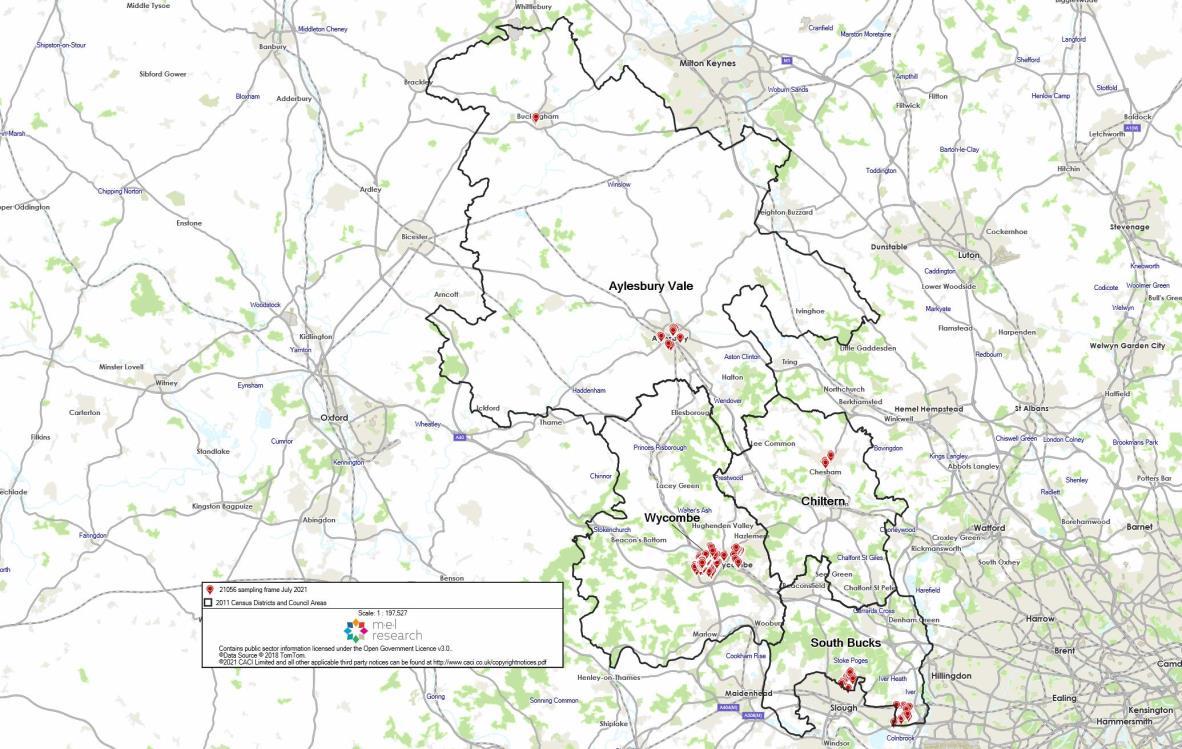
Addresses within Milton Keynes were excluded from sampling. As a consequence, the distribution of the randomly sampled addresses per local authority area was as per the table below.
Table 1: Distribution of sampled addresses for postal push to web survey sampling
All sampled addresses were sent a Listen Learn Adapt branded letter explaining the nature of the survey and the online link through which they could access the survey. The survey could also be accessed via a QR code.
The survey mailing was sent in August 2021 but did not yield the volume of returns anticipated. Furthermore, despite targeting locations with the highest known concentrations of BAME residents, the shape of the initial data was skewed towards White British respondents. While it was a conscious decision of the team to allow White British residents to participate in this research in order to give a point of comparison to the views from other ethnic communities, this phase 1 data did not capture sufficient ethnic diversity.
On this basis, in Phase 2 the Listen Learn Adapt Partnership, supported by M E L Research adopted a much stronger promotional/community engagement approach, raising the awareness of the research through the development of online and offline promotional materials, and targeted engagement with key community leaders and stakeholders. Examples of some of the materials produced including screen grabs of a social media animation produced by the project team are provided below.
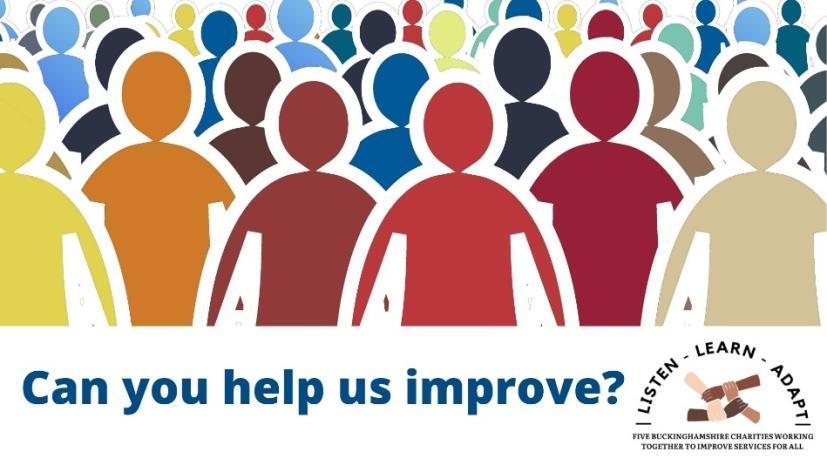

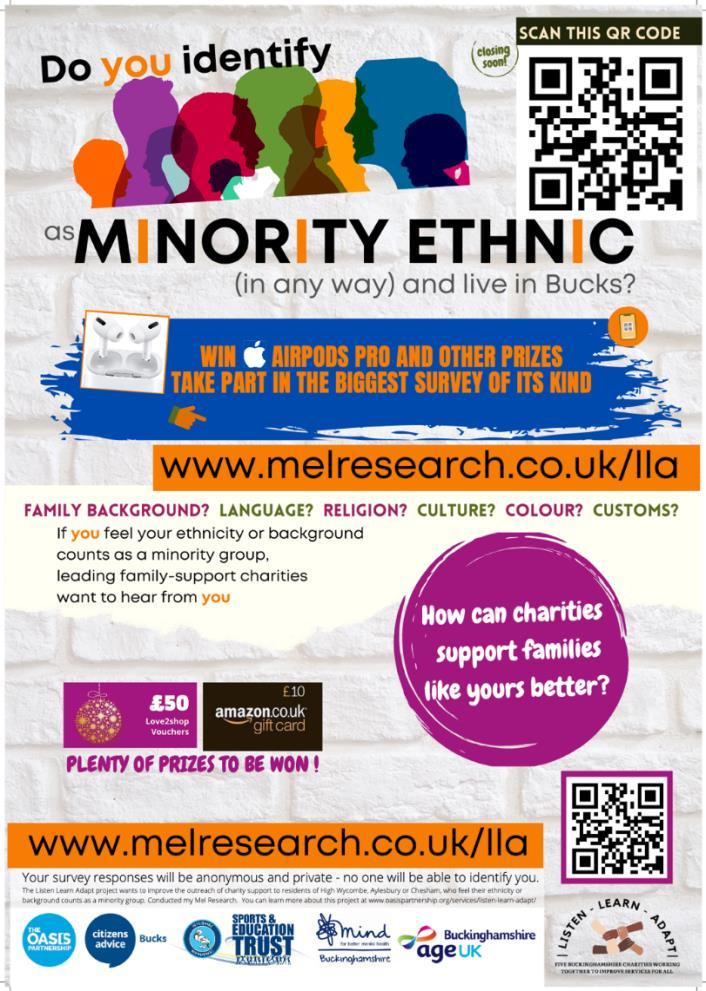
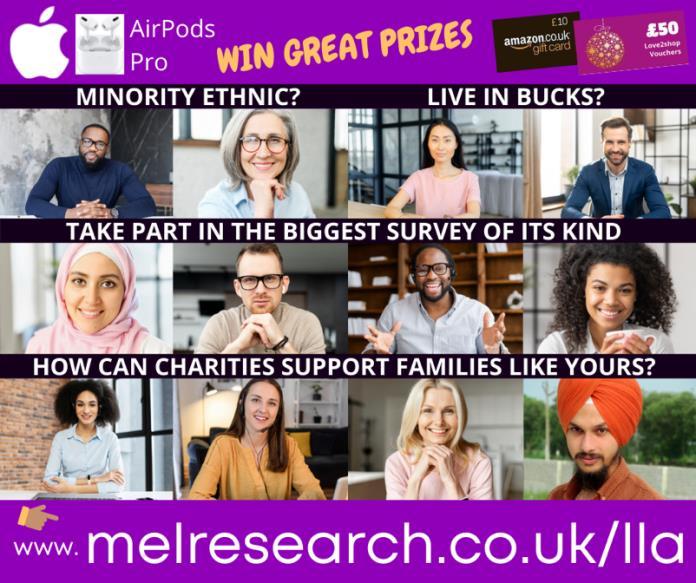
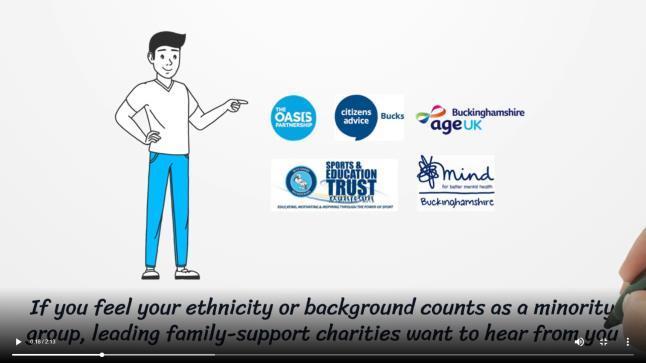
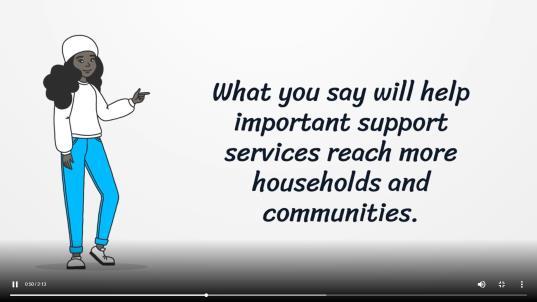
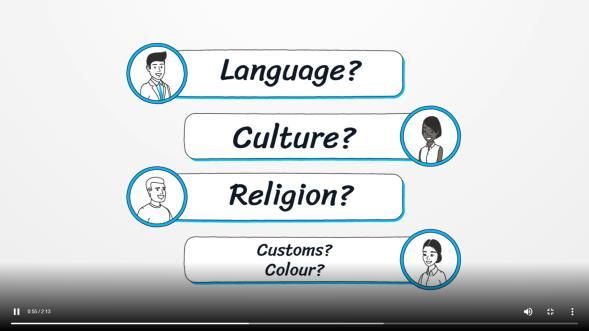
14 prizes were introduced as part of a prize draw to incentivise responses, appealing to a range of age groups - a top prize of popular Apple headphones (retailing around £200) and £50 shopping vouchers for high street stores were among the prizes. The survey was promoted through a range of digital images promoting the survey, and two online videos explaining the aims of the project. It was promoted across a range to channels over a period of 10 weeks in the following ways:
▪ The internal mailing letters of networks, and through relevant council departments.
▪ 147 councillors were contacted via emails, and (where available on the public record) mobile phone
▪ 113 colourful A3 posters were displayed
▪ 1,600+ colour flyers were distributed across 7 community hub sites
▪ 700+ colourful flyers were placed within independent community shops with the permission of the owners
▪ Videos were shared across social media platforms through networks, community institutions and places of worship
▪ Stalls were set up in 5 locations (4 of which were places of worship) to promote the survey
Appendix C: Online survey sample profile
Do you identify as the sex you were assigned to at birth?
Are your day activities limited because of a health problem or disability which has lasted, or is expected to last at least 12 months?
Appendix D: Familiarity with the five named charities
To contextualise the findings of the online survey, respondents were asked to indicate whether, prior to the survey, they were familiar with each charity. The survey included a logo for each to aid recognition. Among minority ethnic respondents the level of recognition ranged from 63% of respondents for Citizens Advice Bucks and 58% for Age UK Buckinghamshire, down to 10% for the Wycombe Wanderers Sports & Education Trust. Awareness of Mind UK was greater with younger respondents: 65% of respondents aged 18-34 against 25% of respondents aged 55+.
Before this survey, were you familiar with any of the following five charities supporting this research?
